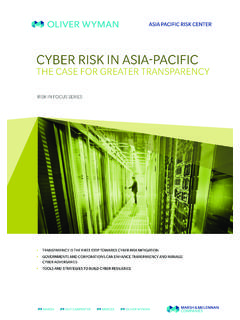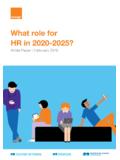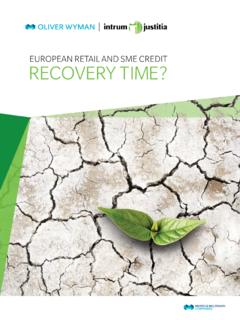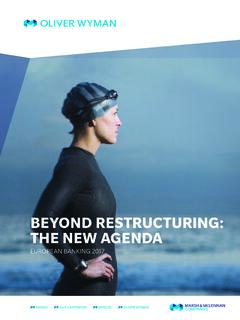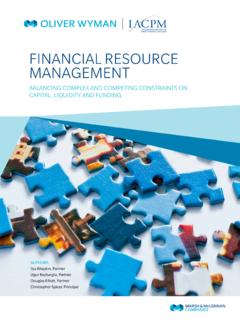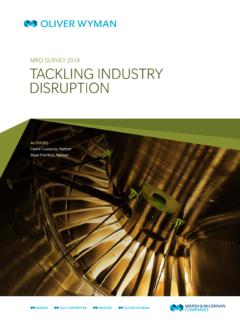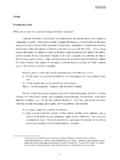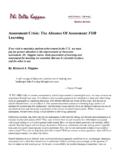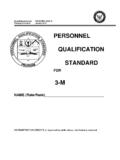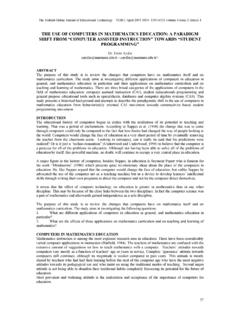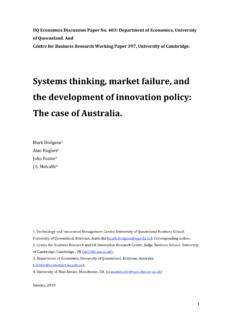Transcription of Responding to a fundamental shift in regulatory expectations
1 Conduct risk for insurersResponding to a fundamental shift in regulatory expectations1 Conduct risk for insurersR Responding to a fundamental shift in regulatory expectationscontentsContents3 Welcome5 Executive Summary7 1. The conduct era: more than just a risk type8 2. Insurer perspectives and industry reaction15 3. Moving beyond TCF22 4. The response30 5. The insurance industry working together31 6. Conclusion32 Appendix: List of participating firms33 Who to contact 2 Conduct risk for insurersR Responding to a fundamental shift in regulatory expectationsThis is a joint report from Oliver Wyman and the Chartered Insurance authors would like to thank the CII for its support and input to this report. They are also grateful to numerous industry participants for their time and the thoughtfulness of their risk for insurersR Responding to a fundamental shift in regulatory expectationsMessage from Oliver WymanWe interviewed twenty two CEOs and senior executives from across the UK insurance industry to understand their views on, and response to, the FCA s Conduct Risk agenda.
2 Participants covered a broad representation of the industry, including life insurers, general insurers, health insurers and report presents our findings from the research and outlines the actions we believe insurers need to take in order to respond to the FCA s main areas of hope that you find the report useful for understanding the implications for insurers of a more open, transparent and accountable market, and in considering your approach to managing Conduct McGuire Tim Kirk Partner, Oliver Wyman Partner, Oliver WymanRichard Thornton James Bryan Partner, Oliver Wyman Partner, Oliver Wymanwelcome4welcomeMessage from the CIIDr Sandy Scott Chief Executive, CIIT here is no doubt that both the Prudential Regulation Authority and the financial Conduct Authority have put conduct, culture and public interest at the very heart of their approach following their formation back in April this the largest professional body in the UK financial services sector, the Chartered Insurance Institute welcomes this focus on improving the culture of the whole financial services sector and we believe that how professionals behave is as important as what they know.
3 We at the CII have actively promoted higher professional standards across our membership and initiatives including the Aldermanbury Declaration and Corporate Chartered Insurers and Brokers are examples of our desire for the insurance sector to attempt to make its own weather rather than rely on meeting a compliance requirement a body that champions higher standards we believe it is right for us to offer challenge to our profession and the insurance sector at large on conduct issues particularly on topics where the public and regulator are demanding report, produced by Oliver Wyman, is designed to help raise the level of debate on the key conduct issues emerging across the insurance sector, and whilst there will be a range of responses to the analysis and recommendations, it does capture the current thinking of leading practitioners on insurance conduct risk. It should also act as a stimulus for future thinking and action across the insurance sectors as well as supporting the dialogue with our new hope you find this report a good starting point for a debate the profession needs to have within itself, with the regulators and ultimately part of a larger conversation with the wider public.
4 Let us hope it will lead to a better dialogue and ultimately better solutions to meet the public risk for insurers: Responding to a fundamental shift in regulatory expectations5 Conduct risk for insurersR Responding to a fundamental shift in regulatory expectationsExecutive summaryMartin Wheatley, Chief Executive of the financial Conduct Authority (FCA), promised at the ABI s 2013 Biennial Conference that the FCA would be: a very different animal to the financial Services Authority (FSA). He set out a positive vision of a successful and competitive market where regulation is not a zero-sum game, and where customers and the best firms can benefit from more competition, better products and better service. In its first months of existence, the FCA has undoubtedly been active, with market studies and thematic reviews of insurance products and operations. And there is no doubt that there is some anxiety amongst insurers in relation both to the workload caused by these reviews, and also to their potential impact on existing ways of doing business.
5 However, it is also the FCA s intention that thematic reviews do not simply add up to a succession of bad news stories; good practice and improvement should also be recognised and order to understand the views of the UK insurance industry towards Conduct Risk more clearly, we interviewed 22 CEOs and other senior insurance executives. These interviews proved to be informative, and exhibited a broad range of views. In summary, we found that: There is a mismatch of expectations between insurers and the FCA There has been an inconsistent response from insurers in both pace and content There are four key emerging issues which will be particularly challenging to address. a very different animal to the financial Services Authority (FSA) executive summary6 Conduct risk for insurersR Responding to a fundamental shift in regulatory expectationsMismatch in expectationsOur interviews revealed that, for some firms at least, a shift to a more transparent and competitive market is regarded as positive.
6 However, in general we found a mismatch in expectations between insurers and the FCA in three key areas:1. The role of the regulator, and level of regulatory intervention, required to address deficiencies in the The practical implications of the new regulatory regime for firms, and the extent of change required to The level of preparedness and progress by insurers in adapting to the new issuesAs we consider the speed and direction of the journey towards a much more open, transparent and accountable market, we see four emerging trends that may become particularly challenging for insurers:1. A focus on good customer outcomes, rather than on actions taken by regulated entities to influence those outcomes. Following the rules is not Defining and proving the value for money of products. Both price and value need to stand up to intense public Pressure to ensure greater equality. This would involve managing the trade-off between individual underwriting and pooling of risks to ensure universal access to insurance, and reducing discrimination between groups or types of Setting the boundaries for the use and management of customer data to ensure that technological progress does not outstrip regulators and customers appetite for responsesIn order to respond, we think that insurers should carry out the following five steps:1.
7 Define their conduct risk appetite and obtain senior stakeholder Perform a conduct risk diagnostic to identify changes Strengthen tools, processes and Realign their business model with good customer Reinforce through leadership actions, culture, training and summary71. the conduct era: more than just a risk type 1. The conduct era: more than just a risk type Consumer protection regulation is not new to the financial services industry, and few would argue against some form of regulation being beneficial to both consumers and firms. However, we consider that the conduct risk agenda being pursued by the financial Conduct Authority (FCA) represents a major change in expectations , and is much more than just a new version of the Treating Customers Fairly (TCF) significant progress and positive intentions by many firms, a continuation of incidents related to conduct risk point towards deficiencies in the way the financial services market operates and in the way some firms manage their products and customer relationships.
8 These include: Target customer markets and product value propositions can be poorly defined, preventing firms from monitoring good customer outcomes effectively. The suitability of individual customers does not always receive sufficient attention, as processes to match products and clients may lack rigour and are insufficiently supported by evidence. Product complexity and bundling remain common, making it harder for customers to make decisions in their own best interests without detailed, structured advice. Tools and infrastructure are underdeveloped. With conduct risk regulation moving the industry even further away from a simple caveat emptor regime, evidence of due process which succeeds in delivering good customer outcomes is paramount. Employee incentives are not always aligned with providing appropriate customer solutions. Given multi-billion pound taxpayer bailouts and significant political pressure, these deficiencies are no longer being tolerated. Regulators in key markets such as the US (Consumer financial Protection Bureau (CFPB)) and the UK (FCA) are concentrating their conduct oversight in dedicated teams or separate agencies, while enacting sweeping regulation that covers both a broad array of conduct-related issues and a new model for supervision.
9 In the UK, the FCA is heavily focused on ensuring that customer interests are embedded throughout all areas of firms, and that all customers experience good if not the best outcomes. This is a matter of strategy and culture for management, much more than simply an issue of process and control. Yet we still see that too many firms are preoccupied with the defensive controls required to manage the regulatory risk (rather than customer detriment), and with seeking to comply with the narrowest interpretation of the rules. The FCA is presenting much more than a new risk type. Boards and executive teams must grasp the scope and extent of the regulator s agenda, and the social and political expectations that drive it. If they do not, they run the risk of missing the strategic implications, and the potential for significant disruptions in the market, as the FCA s interventions start to change the nature of competition, and new business models risk for insurers: Responding to a fundamental shift in regulatory expectations8 Conduct risk for insurersR Responding to a fundamental shift in regulatory expectations2.
10 Insurer perspectives and industry reaction2. Insurer perspectives and industry reaction The requirement to Treat Customers Fairly (TCF) was enshrined in the FSA s original Principles for Business with which all firms were required to comply. Over the years, the concept of treating customers fairly was enhanced and codified by the FSA, culminating in firms being required to demonstrate evidence that they had embedded fairness before 31st December 2008. After a slow start, management teams invested heavily in Responding to the regulator s agenda. However, looking back over the past decade, two things are clear:1. The regulator s expectations have continuously evolved and increased, leading to new areas of regulatory focus and At each stage, while progress has indeed been made, the industry s response has lagged behind the regulator s the creation of the FCA in April 2013, we are seeing a new wave of conduct scrutiny. While the six consumer outcomes explaining what the FSA wanted TCF to achieve for consumers are still applicable, we view the FCA agenda as being substantially more than simply a few tweaks to the TCF FCA has announced its intent to move to a new and more focused supervisory model.


